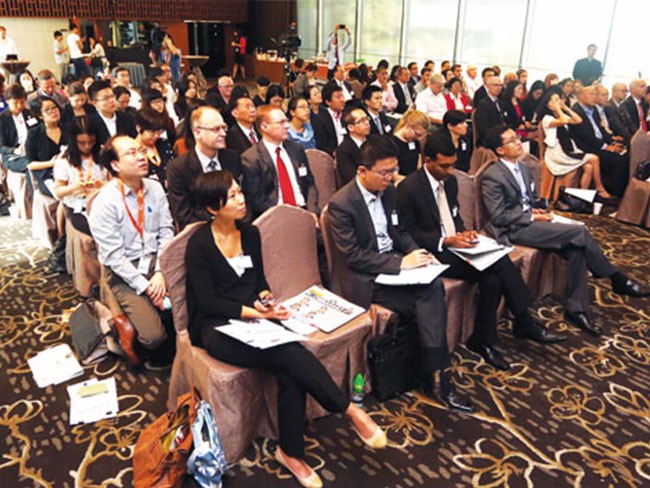2014-09-26

China’s first commercial nuclear power plant at Daya Bay in southern Guangdong Province is best known as one of the earliest and largest joint venture projects undertaken by public and private sectors ever since the country opened up to international trade in the late 1970s. Decades later, China has witnessed propelling growth and has emerged as the world’s second largest economy. But while private investors are eager to share a slice of China’s recent infrastructure boom, many soon realize that the country is still struggling to enhance private capital participation in predominantly State-funded infrastructure initiatives. “We still have a long way to go. More than 90 percent of power assets are State-owned in China,” said Geert Peeters, group director and chief financial officer at China Light and Power (CLP) Group, at a roundtable session co-presented by China Daily Asia Pacific and Asia Society Hong Kong Center on Sept 22. The event was titled Unleashing Asian Dragons: Infrastructure Investments for the Asia Century. The CLP Group financed the Daya Bay nuclear station and holds a 25 percent stake in the power plant. The State-owned China Guangdong Nuclear Power Group owns the remaining shares. There is no denying that infrastructure remains a key engine of growth. “Look at the long list of problems China needs to tackle in infrastructure — traffic congestion, power shortages, urban flooding, ecological and environmental challenges, sewage treatment, air (pollution) and food safety,” said Jason Yeung Chi Wai, deputy chief executive of Bank of China (BOC) Hong Kong. “Infrastructure is a convenient option for governments to control fiscal policies when countries need to boost their economy,” he added. In April, the Chinese leadership pledged to accelerate the construction of railways and housing for the poor by unveiling 80 major infrastructure projects to arrest economic slowdown and create job opportunities. These projects span from railway to harbor construction, and from IT to clean energy projects such as wind and solar power. Given these massive projects in the pipeline, it is not surprising that infrastructure investment in China has risen by 25 percent from January to July this year. Its contribution to GDP has reached 10.9 percent in the same time period this year, from last year’s 5.5 percent, BOC’s Yeung pointed out. Despite the rosy prospect for infrastructure development in China, Yeung remains cautious. “Infrastructure is also about financial infrastructure,” he said. BOC Hong Kong has co-financed a gas project in the Chinese mainland with the Asian Development Bank and other financial institutions. What concerns the commercial banker is a lack of diversity in funding resources. Currently, infrastructure financing is either from direct public funding by the central government or indirect funding from local governments. For instance, the Chinese government provides more than 90 percent of funding for airports and 80 percent of power and utilities projects. The private sector only comes in as the third source. Official data shows private-sector investment accounted for about 60 percent of China’s total capital investment. “Significant infrastructure demand in China will require diversification of funding resources,” Peeters said, adding that the model for financing China’s infrastructure needs to change. Echoing Peeters is BOC’s Yeung. “Right now, money is predominantly from (State-owned) banks. Financing by capital markets in China is very much underdeveloped,” said Yeung, adding that public-private partnerships (PPPs) can provide further financing in infrastructure development. Last year, China led the way with 60 infrastructure projects with private participation. This was followed by 51 in Brazil and 31 in India, said Cledan Mandri-Perrott, lead finance officer and PPP specialist for the Singapore Infrastructure Hub at the World Bank Group. Chinese investors including those from Hong Kong sponsored the 60 projects, either alone or in joint ventures, although 93 percent of these deals were inside China, World Bank data showed. Creating an environment conducive to PPPs is equally important. This particularly holds true for developing countries where political instability remains one of the biggest deterrents for banks and private investors. “We are talking about projects lasting for decades and those with thresholds influenced by political situations. That is why some banks are reluctant to participate,” Yeung said. “What we believe is most needed is public sector oversight in a regulatory framework that can give confidence to private investors.” Experts agree that grievances from the private sector are not disregarded as reforms are gradually underway. According to the communique of the Third Plenum, the first policy blueprint unveiled by the new leadership under President Xi Jinping and Premier Li Keqiang in November last year, “We must ensure the decisive role of the market in allocating resources and further eliminate different forms of monopoly.” Earlier this year, the State Council decided to encourage private investment to enter fields that used to be dominated by State-owned enterprises (SOEs). Public utilities, airport construction, oil and gas projects will be next on the agenda to open up to private investment. “We note and welcome China’s reforms,” said CLP’s Peeters “and the quest of SOEs to access the international capital market,” he added. jennifer@chinadailyhk.com http://www.chinadailyasia.com/2014-09/26/content_15171145.html